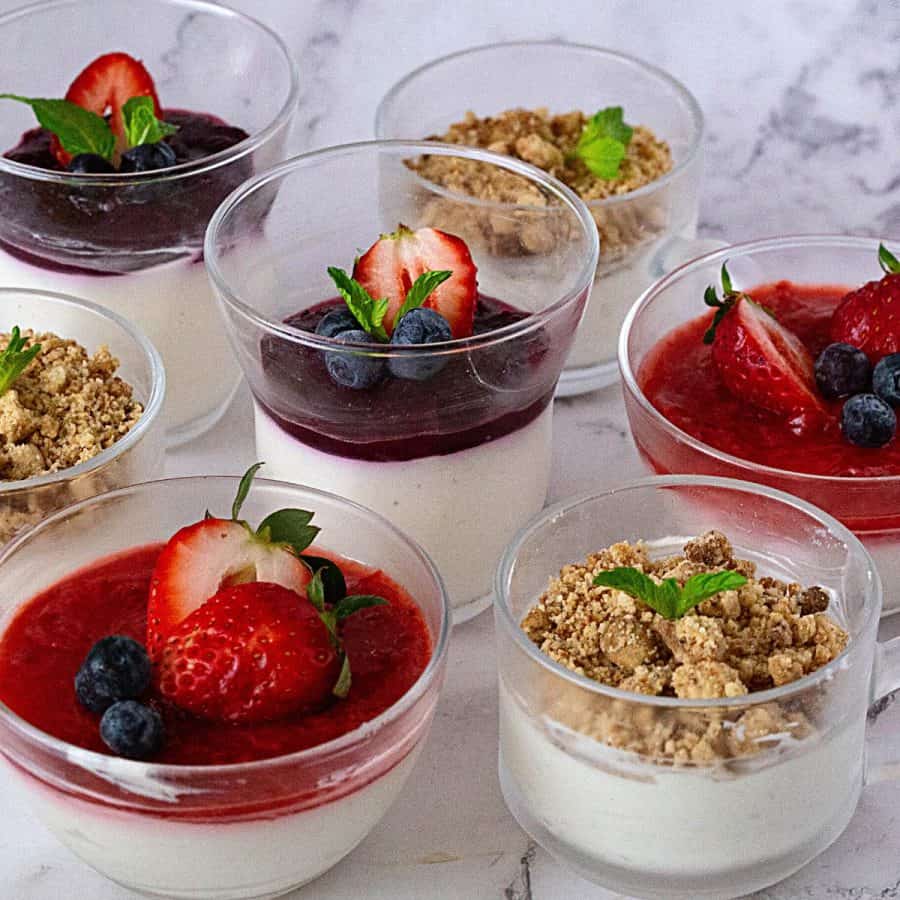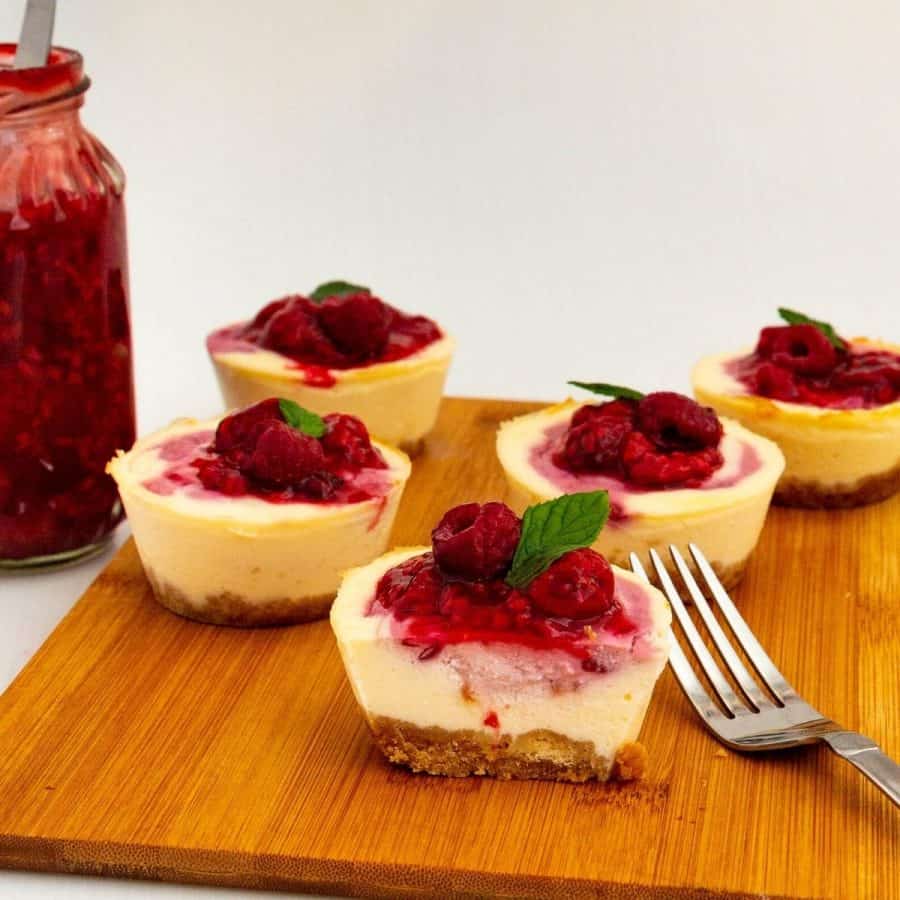Basque Cheesecake, also known as Burnt Cheesecake, is a delightful dessert that originates from the Basque Country in Northern Spain. It was first created in 1990 by Santiago Rivera, a chef at La Viña in San Sebastián, who sought to craft a unique cheesecake that would stand out from the traditional, crust-based versions. Unlike its more delicate New York-style cousin, Basque Cheesecake is characterized by its rustic, caramelized top, which is intentionally burnt to a dark finish, and its irresistibly creamy, slightly undercooked center. What sets Basque Cheesecake apart is its simplicity and the lack of a crust, allowing the rich flavors of the cream cheese and vanilla to shine through, enhanced by a hint of lemon. The absence of a water bath in the cooking process and the high baking temperature contribute to its uniquely appealing texture and appearance, with a slightly charred exterior and a meltingly soft interior. Its popularity comes from its straightforward preparation, the striking contrast between its burnt exterior and lush interior, and its adaptability to various toppings and flavorings. It’s a dessert that makes a statement with its bold look and indulgent taste. Yet, it’s surprisingly easy to make, making it a favorite among amateur cooks and professional chefs worldwide. Today, Basque Cheesecake continues to captivate dessert lovers with its simplicity and exceptional flavor, making it a modern classic in the culinary world.
Why is this the best recipe?
Simplicity of Ingredients: The recipe uses common ingredients found in most kitchens, such as cream cheese, eggs, and sugar, without needing any hard-to-find or specialty items. This makes it accessible and easy to prepare. No Water Bath Needed: Unlike traditional cheesecakes, this Basque Cheesecake does not require a water bath during baking. This simplifies the baking process and reduces the risk of the cheesecake cracking or becoming soggy. Forgiving Nature: The rustic and burnt exterior is not only a signature look but also means that any blemishes or cracks will contribute to its authentic appearance. This makes it ideal for those who may be less experienced with baking cheesecakes. Rich and Creamy Texture: The combination of cream cheese, sour cream, and heavy cream creates a luxuriously smooth and creamy texture that’s hard to beat. The sour cream adds a slight tang that balances the sweetness beautifully. Versatile Flavor Profile: The subtle addition of lemon juice and vanilla enhances the flavor without overpowering it. This allows the natural taste of the cream cheese to shine through while providing a hint of complexity. Quick and Efficient Cooking Time: With a total baking time of around 50-55 minutes and no need for a long water bath cook time, this cheesecake is relatively quick to make compared to other cheesecakes. Plus, the additional oven resting time ensures it sets perfectly without extra effort.
Ingredients and substitutes
Cream Cheese: Forms the base of the cheesecake, providing its primary structure and creamy texture. You can use Neufchatel cheese as a lower-fat alternative, though it may result in a slightly less creamy texture. Sour Cream: Adds richness and a slight tang, enhancing the flavor profile and contributing to the creamy texture. Full-fat Greek yogurt can replace sour cream in equal amounts, offering a similar tang and creaminess. Sugar: Sweetens the cheesecake and helps in caramelizing the top when baked at high temperatures. Granulated white sugar is standard, but you can use an equal amount of light brown sugar for a deeper flavor or a sugar alternative like coconut sugar, keeping in mind that the flavor and color might change. Heavy Cream: Increases the richness and creaminess of the cheesecake, making the texture smoother. For a lighter version, you can also use half-and-half, though the cheesecake might be less rich. Eggs: Act as a binding agent, helping to set the cheesecake as it bakes. They also contribute to its rich texture. There are few substitutes for eggs in cheesecake recipes, as they are crucial for the texture. However, some bakers use silken tofu or vegan egg replacers in specific formulations. Vanilla Extract: Enhances the flavor of the cheesecake, adding depth and warmth. You can also use vanilla bean paste or a small amount of almond extract. Alternatively, bourbon or rum can add a unique flavor twist. All-Purpose Flour: Gives a slight structure to the cheesecake, helping to stabilize it. You can use a gluten-free all-purpose flour blend for those avoiding gluten. Cornstarch or fine almond flour might also work, but experiment with smaller quantities to avoid altering the texture too much. Lemon Juice: Adds a bright note to balance the richness of the creams and cheese, enhancing the overall flavor profile. You can use lime juice for a similar acidic balance. A small amount of white vinegar could also work in a pinch.
Step-by-step: Basque Cheesecake
Oven and Pan: Preheat your oven to 200°C /400°F/ Gas Mark 6. Line a 9-inch springform pan with two pieces of parchment paper, ensuring that the paper comes at least 2 inches above the top of the pan.Pro tip – The wrinkles in the paper give the cheesecake its characteristic rustic look.
Cheesecake Batter: In a large mixing bowl, beat the cream cheese, sour cream, and sugar until smooth and creamy. Add the heavy cream, and vanilla extract, and continue to mix until well combined. Beat in the eggs one at a time, ensuring each is fully incorporated before adding the next. Stir in the flour and lemon juice, mixing until the flour is incorporated.Pro tip – Avoid overmixing to prevent the cheesecake from becoming too dense.
Bake: Pour the batter into the prepared pan. Tap the pan gently on the counter to remove any large air bubbles. Bake in the preheated oven for about 50 to 55 minutes. The cheesecake should be deeply golden brown on top and still very jiggly in the center. Turn off the oven and let the cheesecake sit in the oven for another hour. Cool: Remove the cheesecake from the oven and let it cool to room temperature. Then refrigerate it for at least 4 hours, preferably overnight, which makes it easier to cut.Pro tip – The cheesecake will have a sunken, rustic appearance with a burnt exterior. This is normal and desired for a Basque Cheesecake. Serving: Serve chilled. This cheesecake can be served as is. If desired, top the cheesecake with fresh berries or a dusting of powdered sugar. And, you can also serve it with caramel or chocolate sauce on the side.
Tips for Success
Room Temperature Ingredients: Ensure that your cream cheese, eggs, and sour cream are at room temperature before mixing. This helps achieve a smoother batter without lumps, which is crucial for the creamy texture of the cheesecake. Adequate Beating of Cream Cheese: Beat the cream cheese and sugar together until completely smooth and free of lumps. This is the foundation of your cheesecake’s texture, so take your time with this step. Minimize Air Incorporation: When adding eggs, do so one at a time and mix just until incorporated. Over-mixing once eggs are added can introduce too much air, which might cause the cheesecake to rise too much and then fall or crack. Do Not Overmix After Adding Flour: Once you add the flour, mix only until it’s just combined. Over-mixing the batter after adding flour can activate the gluten, leading to a denser cheesecake. Proper Lining of the Pan: Line your springform pan generously with parchment paper, letting it come up over the sides. The parchment not only prevents sticking but also helps in achieving the rustic, wrinkled appearance typical of Basque Cheesecake. High Baking Temperature: Bake at a high temperature (around 200°C or 400°F). This high heat is essential for creating the iconic caramelized exterior while keeping the interior creamy and slightly underdone. Don’t Worry About Cracks: Unlike other cheesecakes, cracks, and browning (even burning to some extent) are desirable characteristics of Basque Cheesecake. They add flavor and texture, so don’t worry if the surface cracks or darkens significantly. Cooling and Chilling: Allow the cheesecake to cool gradually in the turned-off oven with the door slightly ajar to prevent sudden temperature changes that can cause sinking or cracking. Once cool, refrigerate for at least 4 hours, ideally overnight, to fully set and develop flavors. Serving: Serve the cheesecake chilled or at room temperature, depending on your preference. Its flavor often enhances after a day, making it a great make-ahead dessert.
Cheesecake Ice Cream: A Light and Creamy TreatBlueberry Cheesecake – BakedStrawberry Cheesecake – BakedThe Perfect Baked Cherry Cheesecake Recipe: A Classic with a TwistNo-Bake Strawberry Cheesecake
Frequently asked questions
Creative variations
Matcha Basque Cheesecake: Add two tablespoons of matcha powder to the flour, creating a vibrant green cheesecake with a subtle earthy flavor. Chocolate Basque Cheesecake: Incorporate 1/4 cup of cocoa powder into the cream cheese mixture for a rich chocolatey twist. Espresso Basque Cheesecake: Add two tablespoons of espresso powder to the heavy cream to infuse it with coffee flavor before mixing it into the batter. Lavender Honey Cheesecake: Steep culinary lavender in the heavy cream, strain it, and then mix in honey instead of some of the sugar for a floral, aromatic version. Orange or Lemon Basque Cheesecake: Incorporate the zest of an entire orange or lemon into the batter for a bright, citrusy flavor. Replace lemon juice with orange or lemon juice accordingly. Berry Swirl Basque Cheesecake: Before baking, swirl through a sauce made from blended and strained raspberries or blueberries. The vivid streaks look beautiful and add a fresh, fruity flavor. Caramel Swirl Basque Cheesecake: Drizzle caramel sauce over the top of the batter and use a knife to create a marble effect for a sweet, gooey texture. Nutty Caramel Topping: After baking, top the cheesecake with a layer of caramel sauce and sprinkle chopped toasted nuts (like pecans or walnuts) over it for extra crunch and flavor. Seasonal Fruit Topping: Arrange slices of seasonal fruits such as peaches, plums, or cherries on top of the cheesecake just before serving for a fresh and attractive finish.
Creative ways to serve basque cheesecake
Whipped cream: The light, airy texture of whipped cream pairs beautifully with the rich, dense creaminess of the cheesecake. It adds a delightful contrast and can be sweetened or flavored with vanilla, citrus zest, or a liqueur to complement the cheesecake’s flavors further. Sauces: Caramel or chocolate sauce adds a rich, decadent touch, perfectly complementing the creamy interior and caramelized top. This pairing is especially great for those who enjoy a blend of textures and deeper flavors in their desserts. Deconstructed Basque Cheesecake Parfait: Layer crumbled Basque cheesecake with fresh berries, a dollop of whipped cream, and a drizzle of fruit coulis in a clear glass. This presentation not only looks stunning but also offers a textural variety. Cheesecake Ice Cream: Blend chilled Basque cheesecake with a bit of heavy cream and churn it in an ice cream maker. Serve the cheesecake-flavored ice cream with a drizzle of caramel or chocolate sauce for a luxurious dessert. Cheesecake Truffles: Roll chilled Basque cheesecake into balls and then dip them in melted chocolate. Roll these truffles in crushed nuts, cocoa powder, or toasted coconut for a bite-sized treat perfect for parties.
Did you LIKE this recipe? Save it for later. You can find my recipes on Pinterest. Follow me on Facebook, Twitter, and Instagram.Subscribe, and I’ll send you new recipes right to your inbox.
Thank you for sharing - Save for later

























